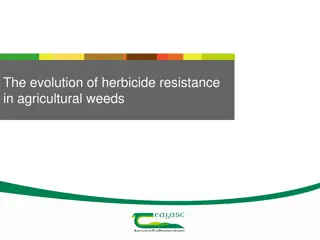Reviewing patients on antibiotic treatment for acne
Understanding the importance of reviewing patients on antibiotic treatment for acne, the resource provides insights on managing acne patients currently on antibiotics, referral considerations, and self-care advice. It emphasizes the need to address antibiotic resistance concerns and the challenges o
0 views • 24 slides
Antibiotic Adaptation in Renal Insufficiency - Dosage Adjustments and Risks
Understanding the importance of adapting antibiotic therapy in patients with renal insufficiency is crucial to ensure efficacy and minimize risks. This content covers various factors influencing antibiotic selection, dosing adjustments based on patient parameters, and the risks associated with inapp
0 views • 52 slides
Peptic Ulcer Disease: Treatment Approaches and Helicobacter pylori Eradication
Common gastrointestinal conditions such as peptic ulcers can be effectively treated through approaches like eradicating H. pylori infection, reducing gastric acid secretion, and using mucosal protecting agents. Helicobacter pylori eradication is crucial for healing ulcers and preventing recurrence,
0 views • 27 slides
Understanding Antibiotic Use in UTI Management: A Critical Review
Antibiotic use in urinary tract infections (UTIs) is crucial, but concerns exist due to rising resistance. E. coli, common in UTIs, can lead to resistant blood stream infections. Proper diagnosis and treatment are essential to combat antibiotic resistance and ensure patient recovery.
2 views • 44 slides
Trends in Gonococcal Resistance to Therapies in England and Wales Since 2011 Guideline Change
Antimicrobial resistance in Neisseria gonorrhoeae poses challenges for treatment. This study examines trends in ceftriaxone, azithromycin, and cefixime resistance since the 2011 guideline change in the UK. Data from the Gonococcal Resistance to Antimicrobial Surveillance Programme is analyzed to tra
0 views • 12 slides
Antibiotic Resistance of Helicobacter pylori in Primary Care: Observational Cohort Study
Research focused on Helicobacter pylori eradication success and antibiotic resistance development in primary care settings, revealing an 8% rate of treatment failure leading to a second treatment within 12 months. The study suggests a need to revise treatment guidelines, potentially targeting specif
0 views • 6 slides
Understanding Ohm's Law and Electrical Resistance
Explore the principles of Ohm's Law and electrical resistance, understanding how resistance affects electron flow in circuits, the relationship between voltage drop and resistance, and practical examples of applying Ohm's Law in circuit calculations. Discover the impact of resistance in wires and ho
0 views • 19 slides
Understanding Water Resistance in Everyday Life
Water resistance is a type of friction experienced when objects move through water, similar to air resistance. This force slows down objects moving through water, like when swimming. Animals and humans adapt by using streamlined designs to reduce water resistance. Experimenting with different shaped
1 views • 11 slides
Understanding Antibiotic Susceptibility Testing
Antibiotic susceptibility testing is crucial in determining the effectiveness of antibiotics against specific bacteria. The Kirby-Bauer method, a standardized paper disk agar diffusion method, is commonly used for this purpose. By observing zones of inhibition around antibiotic disks on agar plates,
1 views • 21 slides
Understanding Herbicide Resistance in Weeds: Insights and Management Strategies
Herbicide resistance is a naturally occurring phenomenon in weed populations, impacting the effectiveness of herbicide treatments. This resistance can be passed down through generations and is influenced by various factors such as cultural practices, herbicide mechanisms, and the biology of weed spe
0 views • 14 slides
Best Practices for Managing Bacteremia and Antibiotic Use
This resource highlights best practices for managing bacteremia and improving antibiotic use in acute care settings. It covers recommendations for blood culture collection, organism-specific management, de-escalation of antibiotic therapy, and duration of antibiotic therapy. The content also discuss
0 views • 33 slides
Combatting Antimicrobial Resistance: A Comprehensive Approach
Infectious Diseases class covers topics such as antibiotic stewardship, bacterial infections, viral diseases, and more. Cautionary statements by Sir Alexander Fleming underline the dangers of antimicrobial resistance, predicting millions of deaths and trillions in economic costs by 2050. The consequ
7 views • 30 slides
Understanding Antibiotic Resistance in E. coli from Poultry, Humans, and the Environment in Malawi
This research project in Malawi investigates the patterns of antibiotic resistance in Escherichia coli isolated from poultry, humans, and the environment. Preliminary results reveal insights into knowledge, attitudes, practices, and microbiological aspects related to antibiotic use. The study aims t
5 views • 8 slides
Antibiotic Prophylaxis Compliance in Rural Queensland Hospitals
Antibiotic prophylaxis is crucial in surgeries to prevent infections. This study aims to determine compliance with prophylactic antibiotic use in surgeries conducted at Gympie, Dalby, and Kingaroy general hospitals in Southeast Queensland. The primary objective is to compare adherence to guidelines
0 views • 18 slides
Understanding Antimicrobial Stewardship in Healthcare
Exploring the critical aspects of antimicrobial stewardship, including the reasons for antibiotic resistance, considerations for prescribing antibiotics, stewardship checklists, and the role of toolkits in promoting responsible antibiotic use to combat resistance. The importance of monitoring, docum
0 views • 20 slides
Understanding Antibiotic Resistance in Healthcare Settings
This case study follows a 64-year-old female presenting with symptoms of acute pyelonephritis, highlighting the challenge of emerging antibiotic resistance. Despite sensitive urine cultures, the patient's condition worsened, shedding light on the importance of identifying risk factors beyond traditi
1 views • 62 slides
Understanding Antibiotic Resistance in Recycled Wastewater
Explore the potential connection between recycled municipal wastewater and antibiotic resistance. Antibiotic-resistant bacteria pose a serious threat, fueled by factors like horizontal gene transfer and high antibiotic dosages in clinical settings. Environmental antibiotic resistance, linked to agri
4 views • 46 slides
Challenges and Trends in Herbicide Resistance Management in Asia-Pacific Region
The Asia-Pacific region faces challenges with herbicide resistance, particularly in countries like China and Australia. Issues include incorrect herbicide application, resistance cases reported, and concerns about glyphosate resistance. Additionally, the introduction of herbicide-tolerant traits in
0 views • 11 slides
Dealing with Resistance in Counseling: Techniques and Strategies
Understanding resistance in counseling is crucial for effective communication and rapport building. This module explores various forms of resistance, counselor behaviors that elicit resistance, and ways to diminish resistance. Learning to respond differently to resistance can lead to valuable feedba
0 views • 27 slides
Understanding Differences in IV Antibiotic Administration in Emergency Departments
Characterizing the shift from intravenous piggyback to intravenous push antibiotic administration in the emergency department, this study highlights the impact of antibiotic timing on patient outcomes, emphasizing the importance of quick and appropriate empiric antibiotic administration. Insights fr
0 views • 21 slides
Antibiotic Prescribing Impact on Clostridium Difficile Risk in Patients on Protein Pump Inhibitors
Antibiotic prescribing in patients on protein pump inhibitors (PPIs) is associated with an increased risk of Clostridium difficile infection. A review was conducted on high-risk antibiotic prescriptions, revealing instances where patients were prescribed against guidelines, leading to potential comp
0 views • 5 slides
Understanding Herbicide Resistance in Agricultural Weeds
This comprehensive content covers the evolution of herbicide resistance in agricultural weeds, including the origins of herbicides, cases of resistance, target site resistance, and non-target site resistance. It explains the definition of weeds, types of herbicides, selective and non-selective herbi
0 views • 32 slides
Understanding Modern Non-inferiority Trial Designs in Antibiotic Development
This article discusses the significance of non-inferiority designs in advancing antibiotic development to combat multidrug-resistant bacteria. It emphasizes the importance of distinguishing between UDR, MDR, and XDR bacterial categories in trial design, highlighting challenges in selecting comparato
0 views • 12 slides
Principles of Antibiotic Policies and Resistance
Antibiotic policies play a crucial role in combating antibiotic resistance. Understanding mechanisms of resistance, proper antibiotic use, and the importance of stewardship programs are key in preserving antibiotic effectiveness. The discovery of antibiotics by Fleming revolutionized medicine, but m
0 views • 32 slides
Antibiotic Stewardship in Nursing Homes
This information discusses the importance of antibiotic stewardship programs in long-term care facilities, specifically nursing homes. It outlines the core elements of such programs, strategies for appropriate prescribing patterns, and how these programs support continuity of care. The content empha
0 views • 26 slides
Understanding Antibiotic Resistance: A Comprehensive Overview
Explore the world of antibiotic resistance through a journey that covers the basics, historical developments, mechanisms, consequences, and current challenges. From the first antibiotic discovery to the impact of overuse, this overview delves into the crucial topic of microbial connections and the r
0 views • 19 slides
Optimizing Antibiotic Therapy for Pathogenic Bacteria and Resistance
Understanding the pharmacokinetic/pharmacodynamic relationships in antibiotic therapy is crucial for maximizing effectiveness against bacteria while minimizing resistance. Different bacterial loads and stages of infection require tailored dosing regimens to achieve optimal outcomes. Monitoring antim
0 views • 35 slides
The Urgent Need for Developing New Antibiotics
Antibiotic resistance has led to devastating consequences, with lives lost and individuals suffering from resistant infections. This urgency is highlighted through real-life cases of individuals facing complications due to antibiotic-resistant bacteria. The narrative follows a 46-year-old man with e
0 views • 19 slides
Innovating Antibiotic Research & Development: The POWER Act Impact
Increased investment in antibiotics and overcoming barriers to development are crucial to combat rising antibiotic resistance. The PATH Act aims to rejuvenate antibiotic R&D by addressing challenges such as competition for funding, limited pipeline drugs, and difficulty in conducting trials due to a
0 views • 11 slides
Understanding Antimicrobial Stewardship in Nursing
Antimicrobial stewardship is crucial in combating antibiotic resistance and promoting appropriate use of antimicrobials. Nurses play a vital role as advocates for correct antibiotic use and are central in patient care, recognizing infections and adverse events. Core elements of antibiotic stewardshi
0 views • 10 slides
Antibiotic Stewardship Awareness Event at University of Pittsburgh
Annual Get Smart Week event at University of Pittsburgh focusing on antibiotic stewardship to raise awareness about the problem of antibiotic resistance. The event featured Dr. Karen Hacker from the Allegheny County Health Department and highlighted the importance of proper antibiotic use to combat
0 views • 6 slides
Antibiotic Resistance in Humans: Impact of Antibiotic Use on Farms
Antibiotic resistance is a growing concern, with evidence suggesting a link between antibiotic use in farm animals and resistant infections in humans. Explore a case study of a Salmonella outbreak in Denmark, where antibiotic treatment failed, leading to fatalities. Learn about the role of selection
0 views • 25 slides
Importance of Antibiotic Sensitivity Testing in Infection Treatment
Antibiotic sensitivity testing is crucial for identifying the most effective antibiotic treatment for bacterial infections. It helps determine the susceptibility of bacteria to antibiotics, guiding clinicians in administering targeted therapy for better outcomes in cases where standard treatments fa
0 views • 11 slides
Antibiotic Prophylaxis in Perioperative Care
Explore the rational approach to perioperative antibiotic use, the importance of antibiotic stewardship in the operating room, and guidelines for selecting and administering antibiotics to prevent surgical site infections. Understand when antibiotic prophylaxis is necessary, which antibiotics to use
0 views • 44 slides
The Growing Threat of Antibiotic Resistance: Strategies and Surveillance in Virginia
Antibiotic resistance poses a significant threat globally, with millions affected and thousands dying each year. In Virginia, efforts are focused on national goals and strategies to combat this challenge, including surveillance, emerging pathogen tracking, and addressing specific issues like carbape
0 views • 11 slides
Challenges and Lessons Learned in Antibiotic Resistance Intervention
This article delves into the challenges faced and lessons learned in developing a participatory learning and action intervention to address antibiotic resistance in Northern Vietnam. It highlights the importance of understanding the local context, engaging stakeholders, building trust, and recruitin
0 views • 12 slides
Complexities of Antimicrobial Resistance in Farm Animals and Public Health
The epidemiology of antimicrobial resistance is multifaceted, involving various sectors such as aquaculture, soil, wildlife, human-animal interfaces, and more. The case study on ceftiofur resistance in chickens highlights the impact of antibiotic use on resistance levels in both animals and humans.
0 views • 4 slides
Successful Reduction of Antibiotic Usage in Italian Poultry Sector
Italian poultry industry has effectively reduced antibiotic use by implementing proactive strategies and a science-based plan. The approach focuses on prevention, sustainable farming practices, and targeted therapies, leading to a significant reduction in antibiotic usage. Key pillars and commitment
0 views • 10 slides
Understanding the Relationship between Decisional Second-Preimage Resistance and Preimage Resistance in Cryptographic Hash Functions
This work delves into the subtle question of when Decisional Second-Preimage Resistance (SPR) implies Preimage Resistance (PRE) in hash functions. It presents a tool for enabling tight security proofs for hash-based signatures by exploring the success probability of adversaries against collision res
0 views • 25 slides
Incidence and Antibiotic Susceptibility of Staphylococcus aureus on Door Handles in Ahmadu Bello University
Environmental microorganisms, like Staphylococcus aureus, play a significant role in morbidity and mortality. This study explores the incidence and antibiotic susceptibility profile of Staphylococcus aureus isolated from door handles in Ahmadu Bello University, Zaria, Nigeria. The research aims to a
0 views • 22 slides







































